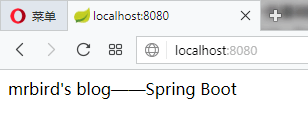springboot原理
springboot-start自动配置
1.pom.xml中**spring-boot-starter-parent指定了当前项目为一个Spring Boot项目,它提供了诸多的默认Maven依赖,具体可查看目录D:\m2\repository\org\springframework\boot\spring-boot-dependencies\1.5.9.RELEASE下的spring-boot-dependencies-1.5.9.RELEASE.pom文件,这里仅截取一小部分:
<properties>
...
<spring-security.version>4.2.3.RELEASE</spring-security.version>
<spring-security-jwt.version>1.0.8.RELEASE</spring-security-jwt.version>
<spring-security-oauth.version>2.0.14.RELEASE</spring-security-oauth.version>
<spring-session.version>1.3.1.RELEASE</spring-session.version>
<spring-social.version>1.1.4.RELEASE</spring-social.version>
<spring-ws.version>2.4.2.RELEASE</spring-ws.version>
<sqlite-jdbc.version>3.15.1</sqlite-jdbc.version>
<statsd-client.version>3.1.0</statsd-client.version>
<sun-mail.version>${javax-mail.version}</sun-mail.version>
<thymeleaf.version>2.1.6.RELEASE</thymeleaf.version>
<thymeleaf-extras-springsecurity4.version>2.1.3.RELEASE</thymeleaf-extras-springsecurity4.version>
<thymeleaf-extras-conditionalcomments.version>2.1.2.RELEASE</thymeleaf-extras-conditionalcomments.version>
<thymeleaf-layout-dialect.version>1.4.0</thymeleaf-layout-dialect.version>
<thymeleaf-extras-data-attribute.version>1.3</thymeleaf-extras-data-attribute.version>
<thymeleaf-extras-java8time.version>2.1.0.RELEASE</thymeleaf-extras-java8time.version>
<tomcat.version>8.5.23</tomcat.version>
...
</properties>
2.当然,我们可以手动改变这些依赖的版本。比如我想把thymeleaf的版本改为3.0.0.RELEASE,我们可以在pom.xml中进行如下配置:
<properties>
<thymeleaf.version>3.0.0.RELEASE</thymeleaf.version>
</properties>
spring-boot-maven-plugin
spring-boot-maven-plugin为Spring Boot Maven插件,提供了:
- 把项目打包成一个可执行的超级JAR(uber-JAR),包括把应用程序的所有依赖打入JAR文件内,并为JAR添加一个描述文件,其中的内容能让你用
java -jar来运行应用程序。 - 搜索
public static void main()方法来标记为可运行类。
定制Banner
Spring Boot项目在启动的时候会有一个默认的启动图案:
. ____ _ __ _ _
/\\ / ___'_ __ _ _(_)_ __ __ _ \ \ \ \
( ( )\___ | '_ | '_| | '_ \/ _` | \ \ \ \
\\/ ___)| |_)| | | | | || (_| | ) ) ) )
' |____| .__|_| |_|_| |_\__, | / / / /
=========|_|==============|___/=/_/_/_/
:: Spring Boot :: (v1.5.9.RELEASE)
我们可以把这个图案修改为自己想要的。在src/main/resources目录下新建banner.txt文件,然后将自己的图案黏贴进去即可。ASCII图案可通过网站http://www.network-science.de/ascii/一键生成,比如输入mrbird生成图案后复制到banner.txt,启动项目,eclipse控制台输出如下:
_ _ _ _ _ _
/ \ / \ / \ / \ / \ / \
( m | r | b | i | r | d )
\_/ \_/ \_/ \_/ \_/ \_/
...
2017-08-12 10:11:25.952 INFO 7160 --- [main] o.s.j.e.a.AnnotationMBeanExporter : Registering beans for JMX exposure on startup
2017-08-12 10:11:26.057 INFO 7160 --- [main] s.b.c.e.t.TomcatEmbeddedServletContainer : Tomcat started on port(s): 8080 (http)
2017-08-12 10:11:26.064 INFO 7160 --- [main] com.springboot.demo.DemoApplication : Started DemoApplication in 3.933 seconds (JVM running for 4.241)
常量引入
Spring Boot允许我们在application.properties下自定义一些属性,比如:
mrbird.blog.name=mrbird's blog
mrbird.blog.title=Spring Boot
@Value
定义一个BlogProperties Bean,通过@Value("${属性名}")来加载配置文件中的属性值:
@Component
public class BlogProperties {
@Value("${mrbird.blog.name}")
private String name;
@Value("${mrbird.blog.title}")
private String title;
// get,set略
}
编写IndexController,注入该Bean:
@RestController
public class IndexController {
@Autowired
private BlogProperties blogProperties;
@RequestMapping("/")
String index() {
return blogProperties.getName()+"——"+blogProperties.getTitle();
}
}
启动项目,访问http://localhost:8080,页面显示如下:

@ConfigurationProperties
在属性非常多的情况下,也可以定义一个和配置文件对应的Bean:
@ConfigurationProperties(prefix="mrbird.blog")
public class ConfigBean {
private String name;
private String title;
// get,set略
}
通过注解@ConfigurationProperties(prefix="mrbird.blog")指明了属性的通用前缀,通用前缀加属性名和配置文件的属性名一一对应。
除此之外还需在Spring Boot入口类加上注解@EnableConfigurationProperties({ConfigBean.class})来启用该配置:
@SpringBootApplication
@EnableConfigurationProperties({ConfigBean.class})
public class Application {
public static void main(String[] args) {
SpringApplication.run(Application.class, args);
}
}
之后便可在IndexController中注入该Bean,并使用了:
@RestController
public class IndexController {
@Autowired
private ConfigBean configBean;
@RequestMapping("/")
String index() {
return configBean.getName()+"——"+configBean.getTitle();
}
}
自定义配置文件
除了可以在application.properties里配置属性,我们还可以自定义一个配置文件。在src/main/resources目录下新建一个test.properties:
test.name=KangKang
test.age=25
定义一个对应该配置文件的Bean:
@Configuration
@ConfigurationProperties(prefix="test")
@PropertySource("classpath:test.properties")
@Component
public class TestConfigBean {
private String name;
private int age;
// get,set略
}
注解@PropertySource("classpath:test.properties")指明了使用哪个配置文件。要使用该配置Bean,同样也需要在入口类里使用注解@EnableConfigurationProperties({TestConfigBean.class})来启用该配置。
通过命令行设置属性值
在运行Spring Boot jar文件时,可以使用命令java -jar xxx.jar --server.port=8081来改变端口的值。这条命令等价于我们手动到application.properties中修改(如果没有这条属性的话就添加)server.port属性的值为8081。
使用xml配置
虽然Spring Boot并不推荐我们继续使用xml配置,但如果出现不得不使用xml配置的情况,Spring Boot允许我们在入口类里通过注解@ImportResource({"classpath:some-application.xml"})来引入xml配置文件。
多环境引入
Profile用来针对不同的环境下使用不同的配置文件,多环境配置文件必须以application-{profile}.properties的格式命,其中{profile}为环境标识。比如定义两个配置文件:
application-dev.properties:开发环境
server.port=8080application-prod.properties:生产环境
server.port=8081
至于哪个具体的配置文件会被加载,需要在application.properties文件中通过spring.profiles.active属性来设置,其值对应{profile}值。
如:spring.profiles.active=dev就会加载application-dev.properties配置文件内容。可以在运行jar文件的时候使用命令java -jar xxx.jar --spring.profiles.active={profile}切换不同的环境配置。
